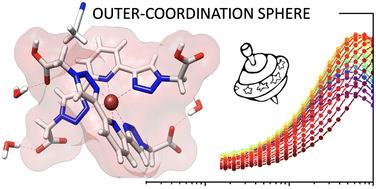当前位置:
X-MOL 学术
›
Dalton Trans.
›
论文详情
Our official English website, www.x-mol.net, welcomes your
feedback! (Note: you will need to create a separate account there.)
Single-ion magnetism in novel Btp-based cobalt complexes of different charge
Dalton Transactions ( IF 3.5 ) Pub Date : 2024-11-12 , DOI: 10.1039/d4dt02338b Gustavo Rama-Martínez, Marcelo Osorio-Celis, Yolanda Sabater-Algarra, Diego Sánchez-Brunete, Antonio L. Llamas-Saiz, Eugenia P. Quirós-Díez, M. Eugenio Vázquez, Miguel Vázquez López, María del Carmen Giménez López
Dalton Transactions ( IF 3.5 ) Pub Date : 2024-11-12 , DOI: 10.1039/d4dt02338b Gustavo Rama-Martínez, Marcelo Osorio-Celis, Yolanda Sabater-Algarra, Diego Sánchez-Brunete, Antonio L. Llamas-Saiz, Eugenia P. Quirós-Díez, M. Eugenio Vázquez, Miguel Vázquez López, María del Carmen Giménez López

|
The magnetic behavior of single-ion metal complexes may be influenced by the nature and composition of the secondary coordination sphere that can be composed of solvent molecules and counterions bound through non-covalent interactions. However, achieving precise control over the outer-coordination sphere of these magnetic complexes to demonstrate its influence on their magnetic properties presents a challenge. A strategy for varying the number of counterions, while simultaneously preserving the arrangement of the ligand atoms around the metal center without altering its oxidation state, is to adjust the overall formal charge of the complex. This adjustment could lead to changes in the magnetic properties of single-ion metal complexes. In this study, we present two novel ligands featuring the coordinating unit Btp (2,6-bis(1,2,3-triazol-4-yl)pyridine). These ligands are equipped with functional groups that can potentially undergo deprotonation. By carefully selecting the solvents used during the crystallization process of the complexes, we can tune at will the charge of the complexes, thus modifying the composition of the CoII complexes’ outer-coordination sphere. We show that, by modifying these conditions, we can tailor the secondary coordination sphere of both charged (mono- and dicationic) and neutral anisotropic CoII metal complexes to show field-induced single-ion magnetism, influencing in turn the size of the barrier to reversal of the magnetization and their slow relaxation process.
中文翻译:

不同电荷的新型 Btp 基钴配合物中的单离子磁性
单离子金属配合物的磁性行为可能受到次级配位球的性质和组成的影响,次级配位球可以由溶剂分子和通过非共价相互作用结合的反离子组成。然而,实现对这些磁复合物的外配位球的精确控制以证明其对其磁特性的影响是一项挑战。改变反离子数量的策略,同时保持配体原子围绕金属中心的排列而不改变其氧化态,是调整络合物的整体形式电荷。这种调整可能导致单离子金属配合物的磁性发生变化。在这项研究中,我们提出了两种具有配位单元 Btp (2,6-bis(1,2,3-triazol-4-yl)pyridine) 的新型配体。这些配体配备了可能发生去质子化的官能团。通过仔细选择配合物结晶过程中使用的溶剂,我们可以随意调整配合物的电荷,从而改变 CoII 配合物的外配位球的组成。我们表明,通过修改这些条件,我们可以定制带电(单向异性和对位)和中性各向异性 CoII 金属配合物的次级配位球,以显示场感应单离子磁性,进而影响磁化反转的势垒的大小及其缓慢的弛豫过程。
更新日期:2024-11-12
中文翻译:

不同电荷的新型 Btp 基钴配合物中的单离子磁性
单离子金属配合物的磁性行为可能受到次级配位球的性质和组成的影响,次级配位球可以由溶剂分子和通过非共价相互作用结合的反离子组成。然而,实现对这些磁复合物的外配位球的精确控制以证明其对其磁特性的影响是一项挑战。改变反离子数量的策略,同时保持配体原子围绕金属中心的排列而不改变其氧化态,是调整络合物的整体形式电荷。这种调整可能导致单离子金属配合物的磁性发生变化。在这项研究中,我们提出了两种具有配位单元 Btp (2,6-bis(1,2,3-triazol-4-yl)pyridine) 的新型配体。这些配体配备了可能发生去质子化的官能团。通过仔细选择配合物结晶过程中使用的溶剂,我们可以随意调整配合物的电荷,从而改变 CoII 配合物的外配位球的组成。我们表明,通过修改这些条件,我们可以定制带电(单向异性和对位)和中性各向异性 CoII 金属配合物的次级配位球,以显示场感应单离子磁性,进而影响磁化反转的势垒的大小及其缓慢的弛豫过程。


















































 京公网安备 11010802027423号
京公网安备 11010802027423号